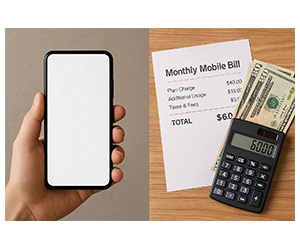Nowadays, a cell phone isn't just a luxury - it's a necessity. From staying connected with loved ones and colleagues to browsing the internet or enjoying entertainment, cell phones play a central role in daily life. However, owning one can quickly become expensive. Thankfully, there are two popular options to ease the burden: free cell phones and affordable cell phone plans. But which one is better for your budget and needs? Let’s dive in!
Understanding Free Cell Phones
What Exactly Are Free Cell Phones?
Free cell phones are provided at no cost, typically through government programs or promotional deals from phone companies. They're designed to help individuals who can't afford regular cell phone expenses gain essential connectivity.
Types of Free Cell Phone Programs
- Government Assistance Programs: In the U.S., programs like Lifeline Assistance offer free or discounted phones along with a limited amount of monthly talk, text, and sometimes even data to qualified individuals.
- Phone Company Promotions: Companies often run promotional deals offering free or heavily discounted phones when you commit to a specific service plan or contract.
Important Considerations:
- Limited Features: Free phones typically have basic features and might not support advanced apps or capabilities.
- Usage Restrictions: Plans often come with monthly limits on minutes, texts, or data usage.
- Eligibility Requirements: Government-backed programs have strict eligibility criteria like income thresholds.
- Contractual Obligations: Promotional offers might require lengthy commitments or contracts.
Exploring Affordable Cell Phone Plans
What Are Affordable Plans?
Affordable plans are budget-friendly options provided by various carriers that allow you greater flexibility in choosing your phone, service features, and monthly costs.
Benefits of Choosing Affordable Plans:
- Better Service Quality: Typically offer stronger network coverage and faster internet speeds.
- Wide Selection of Phones: Choose from entry-level smartphones to the latest premium devices based on your budget and preferences.
- Customized Plans: Select exactly how much talk, text, and data you need each month.
- No Eligibility Restrictions: Open to everyone without income or other qualifications.
Comparing the Costs Side-by-Side
Free Cell Phones:
- Upfront Cost: Usually free.
- Monthly Fees: Low or none, but with strict usage limits.
- Phone Features: Basic functionality with limited smartphone capabilities.
- Extra Charges: Potential fees for exceeding monthly limits or activation charges.
Affordable Plans:
- Upfront Cost: You may need to buy a phone initially unless you already own one.
- Monthly Fees: Vary widely, but plans can be tailored to fit almost any budget.
- Phone Features: Access to fully-featured smartphones and advanced capabilities.
- Flexibility: Easily adjust plans to match changing needs without strict restrictions.
How to Decide What's Best for You
Assess Your Budget
- Limited Budget: If monthly fees seem overwhelming, a free cell phone program might be the best option.
- Some Financial Flexibility: If you're able to manage a modest monthly payment, affordable plans often provide better long-term value and convenience.
Consider Your Usage Needs
- Basic Communication: If you only need basic calling and texting, free phones may be sufficient.
- Advanced Usage: If you regularly use apps, browse the web, or stream media, affordable plans with better devices will serve you much better.
Check Your Eligibility
- Free Programs: Confirm your eligibility for government assistance programs.
- No Restrictions: Affordable plans are available to all customers without qualification requirements.
Evaluate Long-Term Value
- Free Phones: Attractive upfront savings but limited features and usage may cause inconvenience over time.
- Affordable Plans: May have initial costs but deliver superior functionality, flexibility, and overall value in the long run.
Expert Tips for Making the Best Choice
- Research Providers: Compare multiple companies for pricing, coverage, and reputation.
- Read the Fine Print: Carefully review contracts or promotional terms to avoid unexpected obligations or hidden fees.
- Seek Advice: Talk with friends, family members, or trusted professionals to get recommendations.
- Plan for the Future: Consider how your mobile usage might evolve to ensure your choice stays relevant.
Conclusion - Choosing What's Right for Your Wallet
Ultimately, deciding between a free cell phone and an affordable plan comes down to your unique situation, needs, and financial capacity. Free cell phones are great for basic needs and strict budgets, while affordable plans offer richer features and flexibility for a modest investment.
Take the time to carefully assess your budget, usage patterns, and long-term expectations. With thoughtful consideration, you'll find the ideal option to keep you connected without breaking your budget.
